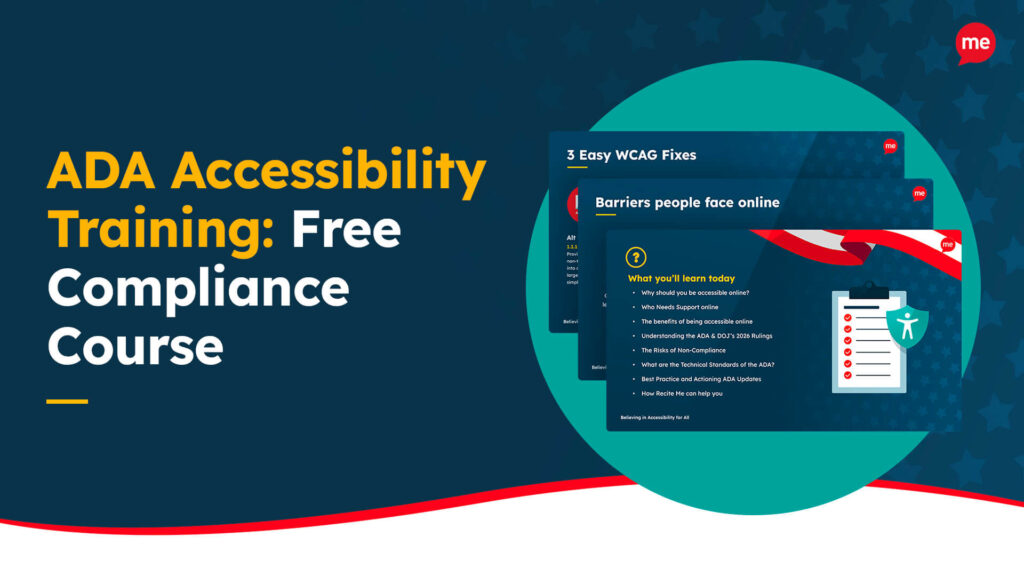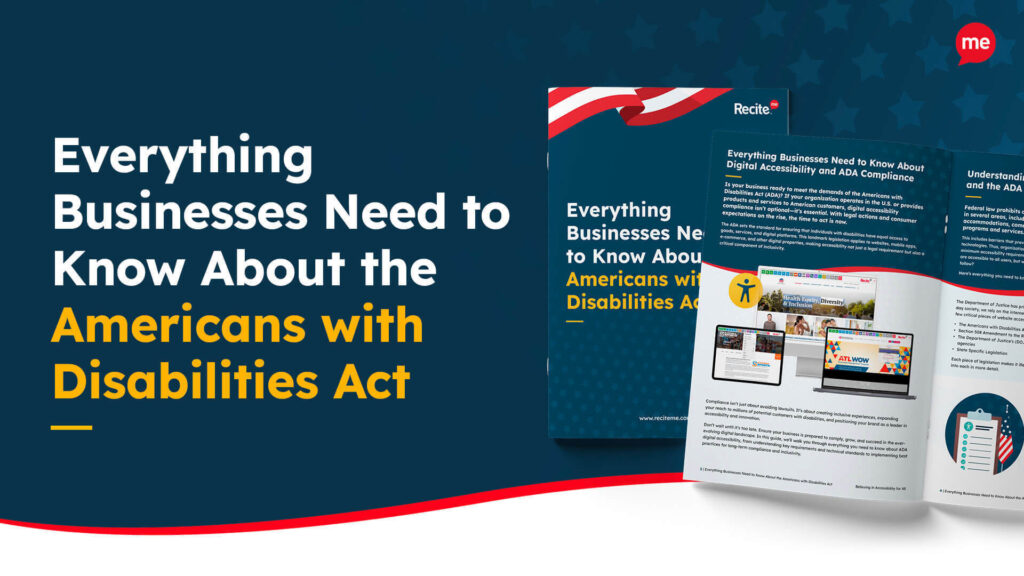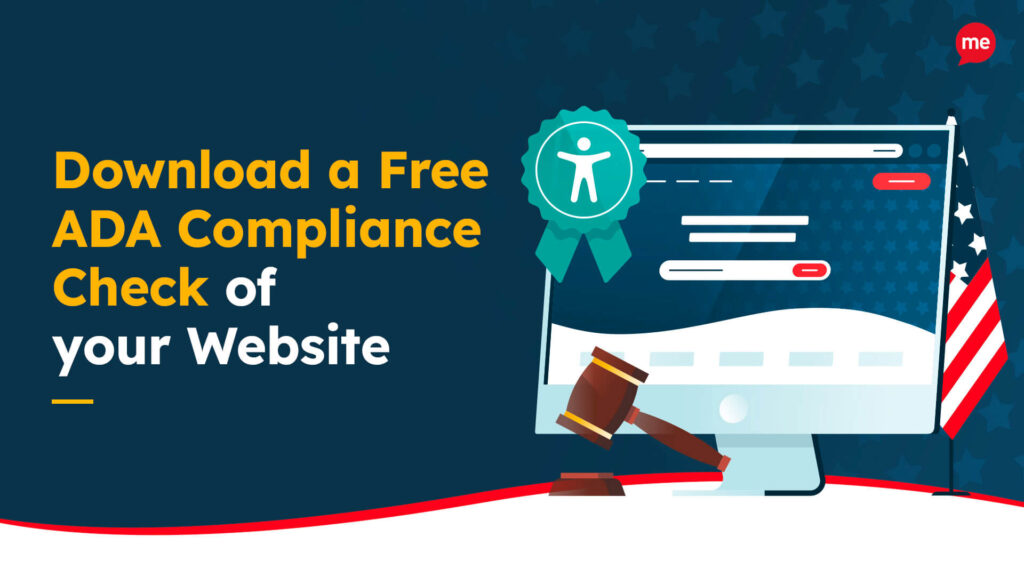Get A Free ADA Compliance Audit Of Your Website
Download NowIf you are a business owner in Tennessee, you may have heard of the Americans with Disabilities Act (ADA). For a long time, compliance with the ADA has meant accommodating disabled individuals by amending company procedures and physical spaces accordingly.
But compliance does not stop there. Did you know that the ADA applies to your website too? If your website is not up to scratch, you could end up facing a lawsuit, along with 4,605 other Americans, according to 2023 data. Most of these lawsuits result in hefty fines or court-ordered corrective action. To avoid this, and to learn more about what ADA web compliance means for your business, read on.
What is the Americans with Disabilities Act (ADA)?
The ADA is a civil rights law that was created in 1990 with the goal of equalizing access to products, services, and opportunities for disabled people. It prohibits discrimination against those with disabilities in all areas of public life. In this way, it was a major turning point in the lives of America’s disabled population.
The act itself is composed of five unique elements, called titles. Each one outlines the accessibility obligations of a different sector. Let’s have a look:

- Title I (Employment): Prevents discrimination in the workplace and requires employers to provide reasonable accommodations to cater for their disabled employees’ needs.
- Title II (State and Local Government): Requires all state and local government agencies, including public schools and transportation, to ensure their programs, services, and activities are accessible to those with disabilities.
- Title III (Public Accommodations): Applies to any business or non-profit service that is open to the general public.
- Title IV (Telecommunications): Mandates that telephone and internet companies provide accessible communication services.
- Title V (Miscellaneous Provisions): Contains various provisions, including prohibiting retaliation against individuals asserting their rights under the ADA.
Title III is particularly relevant to business owners, as it covers public accommodations. This includes restaurants, hotels, theaters, stores, and crucially, websites.
While Title III originally pertained exclusively to physical spaces, it is now frequently interpreted by courts of law to include websites. This is because websites, just like brick-and-mortar stores, serve the public. Websites provide services, sell products, and are open to anyone willing to visit them, making them public accommodations in the eyes of the law.
Want to make sure your website is compliant with the Americans with Disabilities Act? Then unlock the ADA compliance checklist now. Discover actionable steps to ensure ADA compliance, helping you avoid lawsuits and any other negative consequences of non-compliance.
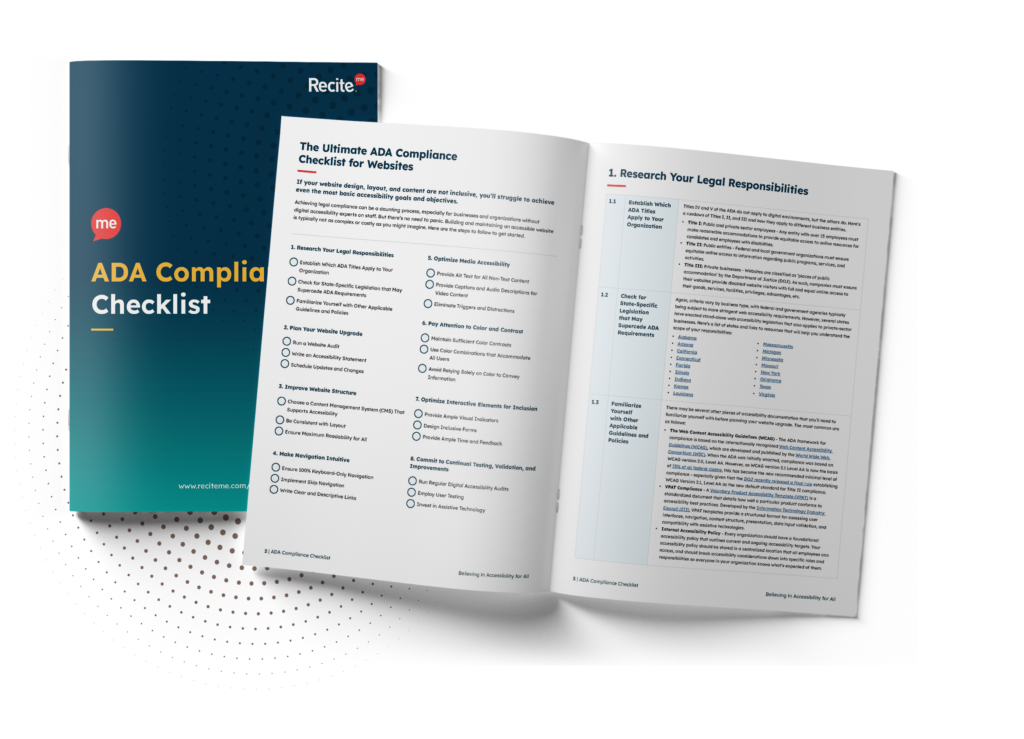
Who needs to comply with ADA guidelines in Tennessee?
The ADA applies to both public and private sector organizations, but the requirements can vary depending on the type of organization and the number of employees. In Tennessee, the following entities must comply with ADA guidelines:

- Businesses with more than 15 employees: If you run a small business with fewer than 15 employees, you are still encouraged to follow ADA guidelines, but the law applies directly to businesses with 15 or more employees.
- State and local governments: Local government websites, including those for Tennessee counties and cities, are required to be ADA-compliant.
- Public accommodations: This includes any business or service that is open to the public, such as restaurants, retail stores, healthcare providers, and educational institutions. If your business has an online presence, this requirement extends to your website too.
In practical terms, the ADA’s broad remit means that very few businesses are exempt from ADA requirements. However, even if your organization is technically exempt, it’s wise to adopt ADA standards so that you can safeguard against future lawsuits while also opening your doors to a wide range of potential customers.
What are the consequences of ADA non-compliance in Tennessee
The number of lawsuits filed against businesses for digital accessibility violations has surged in recent years. But why should you care? Well, ADA lawsuits bring with them a cascading effect of negative consequences, some direct, some indirect. And unfortunately, once the dominoes start to fall, there is little you can do to remedy the situation. In this section, we examine the dangers of ADA non-compliance in further detail.
Penalties and legal fees
Any Tennessee organization found in breach of the ADA’s requirements can be sued. Legal fees for defending against a lawsuit can add up quickly, and if the case goes to court, the costs can run even higher. If found guilty, the court will likely impose fines, which can be in amounts up to $75,000 for first-time violations and $150,000 for subsequent offenses.
Reputation damage
Inclusion is a topic held dear to many people. It has come to represent corporate responsibility and inform ethical purchasing decisions. That’s why ADA lawsuits, more so than others, seem to attract media attention. A negative public image can affect your reputation and drive customers away. In a world where consumer trust is everything, this can be disastrous for your business.

Disruption to existing projects
Lawsuit settlements typically mandate court-ordered corrective action. This could mean an overhaul of your website, changes to company procedures, training of staff, or a combination of all three. Either way, implementing these things takes time and budget away from existing or pre-planned projects. This can cause a ripple effect of disruption to echo across your organization.
Lost business opportunities
According to the U.S. Census Bureau, 10.7% of Tennessee residents under the age of 65 have a disability. This is a significant portion of the population and a huge market segment. But failing to comply with ADA requirements is failing to serve this community. The result? A large pool of potential customers lost, choosing to take their business to more inclusive organizations where they feel welcome.
Tips for Tennessee ADA web compliance
Now that you understand the risks of non-compliance, it’s time to focus on what proactive steps you can take to avoid them. Here are some tips to help you get started.
1. Start with an accessibility audit
An accessibility audit of your site is the most logical place to start. Without it, any efforts to improve accessibility are mere guesswork. Automated tools, such as an accessibility checker, can help you rapidly identify problem areas, informing your accessibility strategy going forward.
Learn more about completing an ADA audit here.
2. Improve color contrast
Ensure that your website’s text has a high enough contrast against its background to make it readable for users with visual impairments. This means opting for classic color combinations like black and white or light gray and dark blue. For normal-sized text, color contrast ratios should meet a minimum threshold of 4.5:1.
3. Ensure descriptive link text
Descriptive link text helps users with screen readers understand where the link will take them, so avoid vague link text like “click here” or “read more”. Instead, opt for text which describes the link destination, such as “view our Tennessee product catalog” or “explore accessibility services in Tennessee”.

4. Add alt text
Every image on your website should have a clear, descriptive alt text. This helps users who rely on screen readers to understand the content of your images. A good rule of thumb is to describe the image as if you were explaining it to someone who can’t see it.
5. Use accessible fonts
Choose fonts that are easy to read for everyone, including people with dyslexia and visual impairments. This means avoiding overly stylized fonts and instead opting for clear, legible sans-serif fonts like Arial or Verdana.
6. Make sure your website is keyboard navigable
Some users with disabilities may not be able to use a mouse, so it’s important that your website can be navigated using just a keyboard. This means that buttons, links, forms, and menu options can all be completed or activated using keyboard functions like Tab and Enter.
7. Train your team on accessibility
Training your staff helps ensure accessibility across every aspect of your organization, not just your website. Offer workshops on topics like ADA web compliance or best practices for implementing Web Content Accessibility Guidelines (WCAG). Tennessee businesses can even explore training resources from organizations like the Tennessee Disability Coalition, which offers accessibility education and advocacy programs.
Download the free ADA accessibility training course here.

8. Provide captions and transcripts for multimedia
If your website includes videos or audio, make sure to provide captions and transcripts where possible. This will help users with hearing impairments follow along.
Get a free automated ADA compliance audit of your website. This audit will highlight compliance violations and provide the recommendations needed to meet ADA compliance standards.
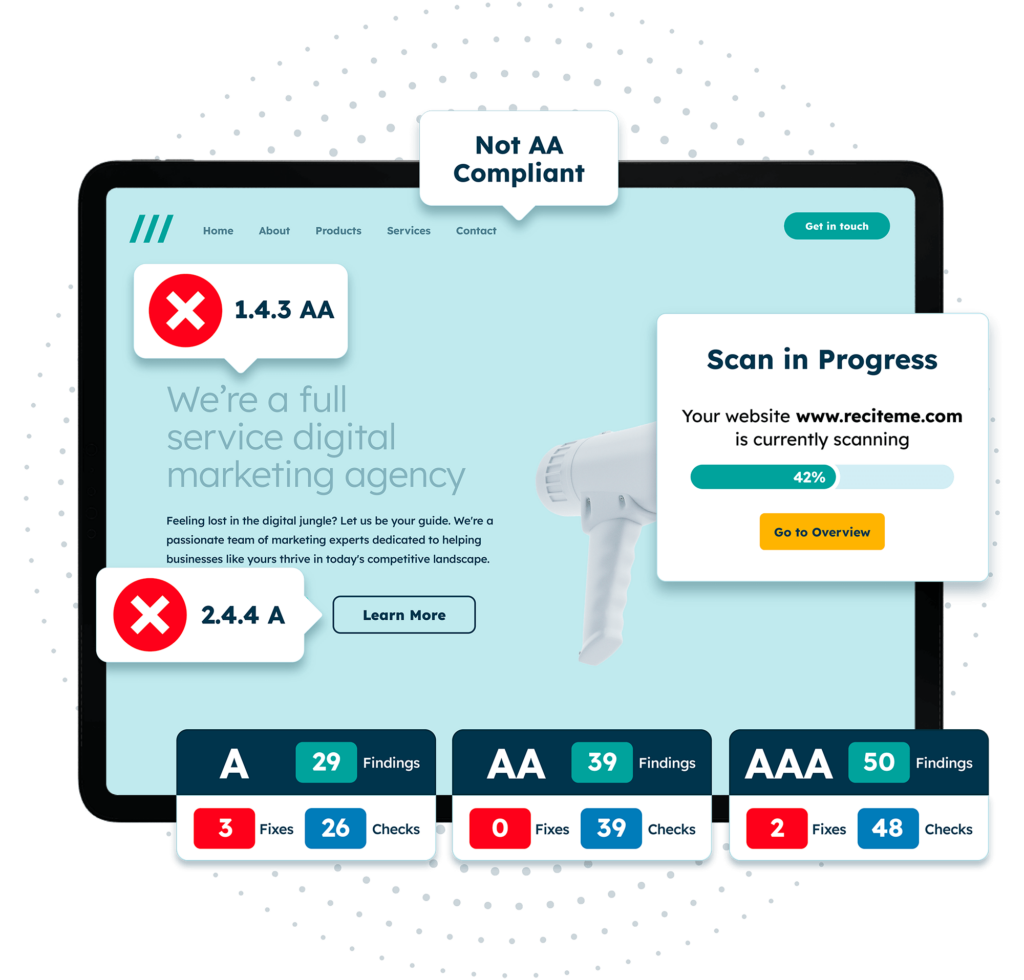
Real world examples of Tennessee ADA lawsuit
So, you’re aware of what it takes to comply with the ADA, and the dangers if you don’t. But what does this look like in practical terms? In this section, we unpack some real-world ADA Tennessee lawsuits.
Lane v. State of Tennessee
Lane v. State of Tennessee was a landmark ADA case questioning the accessibility of Tennessee’s judicial program for people with disabilities. Filed in 1998 by George Lane and Beverly Jones, the lawsuit alleged violations of Title II of the ADA.

In 2004, the U.S. Supreme Court ruled that individuals with disabilities could seek damages when denied access to government services. A settlement was agreed between the plaintiffs and the state of Tennessee, where the state agreed to adopt policies ensuring judicial accessibility, while 25 counties were mandated to improve courthouse access. Many counties have since modified existing buildings or constructed new, accessible courthouses to comply with the agreement.
Good Times Restaurants, Murfreesboro, Tennessee
In this case, Good Times Restaurants, Inc. settled an ADA lawsuit for $352,000 after its Murfreesboro location in Tennessee, called Bad Daddy’s Burger Bar, allegedly denied service to children using wheelchairs and their parents.
The restaurant cited fire hazard concerns, despite being less than half full. The families, who were in town for a youth wheelchair basketball tournament, were forced to dine elsewhere. The settlement provides $34,000 to each of the eight affected families and includes an $80,000 civil penalty. Good Times also agreed to implement new ADA policies and staff training to prevent future violations. The claims were settled without an admission of liability.

Need more help becoming ADA compliant?
The following resources are packed full of actionable tips and expert advice for making your digital content compliant with the Americans with Disabilities Act:
Free ADA Accessibility Training
Take the first step to ADA compliance by completing our training course.
Free ADA Accessibility Guide
Ensure your organization is meeting the requirements for ADA compliance.

